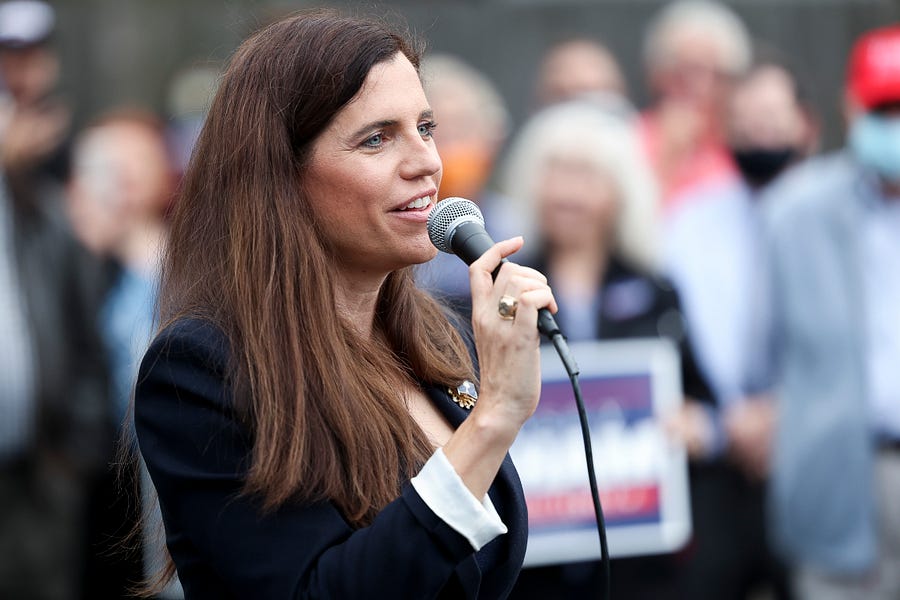One of the ancillary effects of the Democrats gaining 41 seats and taking control of the House in the 2018 midterms was that it left the GOP with its fewest number of female representatives in 25 years. Only 13 Republican women out of 52 won their races, and up-and-coming figures like Mimi Walters and Mia Love were not among them. How long would it take for the party to recover?
Not long, as this election cycle proved. At least 28 Republican women won House races this year, and they made up an overwhelming majority of the flipped seats in the chamber. While much attention has been paid to extremist candidates like Marjorie Taylor Greene in Georgia and Lauren Boebert in Colorado, the other incoming female Republicans include entrepreneurs, seasoned journalists, and career public servants.
Despite months of polling to the contrary, Republicans—through grassroots recruitment, campaigning, and fundraising—flipped up to 14 House seats. And women won at least nine of those races. (Mariannette Miller-Meeks is expected to win Iowa’s 2nd District but after a recount her lead is only six votes.)
They won by touting their commitment to economic growth, slashing regulations, and promoting industries important to their district. And in some cases by connecting their opponents to the Democratic party’s far-left fringes. Maria Elvira Salazar unseated Rep. Donna Shalala in Florida’s 27th District by decrying socialism, while Nicole Malliotakis successfully aligned Democratic incumbent Max Rose in New York’s 11th District with progressive Rep. Alexandria Ocasio-Cortez in the minds of voters.
In conversations with Reps.-elect Ashley Hinson of Iowa, Michelle Fischbach of Minnesota, Stephanie Bice of Oklahoma, and Nancy Mace of South Carolina, another surprising yet encouraging trend emerged: Fiscal conservatism can still win elections.
Nancy Mace
“About 25 years ago, when I was 17, I actually dropped out of high school. I’m the daughter of a retired army general and a retired school teacher, and my parents said if you’re going to stop going to school, then you’re going to start going to work,” said Nancy Mace, who unseated Democratic Rep. Joe Cunningham in South Carolina’s tightest House race. “So I took a job as a waitress at a Waffle House off the side of the interstate in a very small town just outside of Charleston, South Carolina. I learned some very tough lessons during some very tough times. I learned the value of hard work.”
After completing high school by taking classes at a local community college, Mace went on to become the first woman to graduate from the Citadel’s Corps of Cadets—a success story that she attributes, in part, to the late Justice Ruth Bader Ginsburg.
“1996 was the year that Justice Ruth Bader Ginsburg wrote the majority opinion on a Supreme Court case against the Virginia Military Institute, that said if you are a government-funded university or institution of higher learning, you could not discriminate based on gender,” Mace explained. That very same day, the Citadel decided to open its doors to women.
The Citadel was a launching point for Mace, who makes it clear that she’s not one to shy away from a challenge. Come January, Mace—a mother of two—will be sworn in as the first Republican woman elected to Congress from South Carolina. Once in office, Mace promises to act as a “caucus of one,” pursuing policies important to her district like environmental conservation, Veterans Affairs, and fiscal responsibility.
“For decades, both sides have made deals to increase spending in one area in exchange for an increase in spending in another area. No one has been held accountable for this spending. Now we’re facing an enormous crisis, an unprecedented challenge, and the problem is getting worse, not better,” Mace told The Dispatch. “We’ve gotta ensure that no matter what happens in the next couple months that we take it seriously and that we find measured ways, over time, to cut spending and balance the budget.”
When asked if she would support another coronavirus stimulus bill vis-à-vis the $2.2 trillion CARES Act, Mace offered a conditional yes. The problems with the first relief package, she contended, were in its sweeping unemployment assistance. Like many critics of the extra $600 in unemployment benefits per week, Mace pointed out that the payments deterred workers from seeking new employment, citing firsthand encounters with lowcountry restaurants struggling to restaff following shutdowns.
“We are the greatest country in the world and our success is dependent upon our freedom and our ability to be productive members of society,” she said. “People want to live, work, and retire in the best place in the world.”
Ashley Hinson
When Ashley Hinson ran for the Iowa statehouse four years ago after a long career in broadcast journalism, it was because she “wanted to stop talking about it and start doing something about it.” After a narrow victory over incumbent Democratic Rep. Abby Finkenauer in Iowa’s 1st Congressional District, Hinson says she will carry this mentality to Washington.
“In Iowa, I saw the complete mismanagement of the budget and overspending to the point where Republicans had to make across-the-board cuts when they regained control to get the fiscal house in order,” Hinson told The Dispatch. “When a seat opened up, I said to my husband—I’m going to run. I had to think, I’m going to leave my well-paying job for a chance at maybe winning a seat that maybe pays $25,000 to get yelled at at public forums. And it was absolutely the right decision.”
A career in national politics will allow Hinson to tackle the problem of overspending at the federal level, where, she argues, political games currently inhibit necessary legislation from being passed. COVID relief should be the first priority of the next Congress, Hinson said, but Republican cooperation is unlikely if Democratic representatives use it as a vehicle for unrelated spending and social programs.
“Several packages proposed this year, that the House passed and knew were going nowhere, were full of Washington pork. Things that were not even related to COVID relief. I think that’s exactly why people are upset with politicians in Washington, D.C. right now, because they’d rather play politics and pander to their base, rather than doing what we absolutely need to get done right now—which is providing targeted relief to families, businesses, and workers,” Hinson said. “We love our Iowa pork producers. We don’t like Washington pork.”
But Hinson is optimistic in her fellow incoming representatives to effect change in the House. “Our freshman class is very representative of the country. You have women, you have veterans, you have minorities,” she said, adding that intellectual diversity is another important hallmark of the incoming class. “The variety of perspectives under one roof is broad. And I think that’s fine. And that’s what we need to get back to understanding and accepting in this country—it’s okay to have disagreements, even with people you mostly agree with.”
Stephanie Bice
Like Mace and Hinson, Stephanie Bice secured one of the 31 congressional districts won by both a Democrat in the 2018 midterm elections and Trump during the 2016 presidential election. The former state senator beat Rep. Kendra Horn, Oklahoma’s lone Democrat in Congress, by more than 4 points.
Bice was endorsed by President Trump but she has marketed herself as a political moderate and small-government conservative to appeal to pragmatic voters in the Sooner State. As Oklahoma reels from the dual economic challenges of the coronavirus and the downturn of the oil and gas industries, Bice’s campaign promises of economic growth and deregulation have struck a chord with voters.
“Government doesn’t do things well,” Bice told The Dispatch. “There’s too much bureaucracy and red tape. I’ve seen it on the state level and I know that it exists on the federal level as well. A smaller federal government is how our Founding Fathers imagined it would function, and unfortunately when you grow it, it’s very difficult to shrink it.”
“In Oklahoma we’re a balanced budget state, which means you can’t spend what you don’t have, which is unlike the federal budget,” she continued. “Where are ways that we can streamline government? Where can we reduce [duplication] to save money? How do we fund core services but make sure we’re doing it in a way that we’re not wasting taxpayer dollars? I was able to do that on the state level and that’s something that I’ll continue to look at in Congress.”
Bice, in addition to being the first Iranian-American elected to Congress, will also be the first female class president representing 42 incoming Republicans after being chosen by her peers during the House orientation. “There were two women who ran for that position, myself and Michelle Park Steel. I think it’s only fitting that, in the 100th anniversary year of women’s right to vote, the largest incoming freshman class of women on the GOP side would be represented by a woman,” she said.
Michelle Fischbach
During her eight terms in the Minnesota state senate and tenure as lieutenant governor, Fischbach earned her reputation as a constituent-focused public servant—delivering on campaign promises and developing face-to-face relationships with Minnesota residents. Combined with a mobilized Trump base in the district (Fischbach hasn’t been shy about her support for the president), this political experience delivered Fischbach a sizable victory in what was supposed to be one of the country’s tightest House races.
Fischbach beat Democratic Rep. Collin Peterson by nearly 14 points. In response to losing his seat after three decades of representing Minnesota’s 7th District, Peterson pointed to the “partisan tilt” furthered by motivated Republican voters and outside campaign funding.
To Fischbach, coronavirus relief and economic recovery should be the first thing on the agenda for the incoming congress. “Democrats passed, particularly in the House, some really ridiculous liberal wishlist bills. What we really need to be doing with those bills is really focusing them, looking at small businesses that have suffered. We need to target that relief and make sure we’re helping people who need it.”
Fiscal conservatism is a recurring theme for Fischbach.
“I know that we have to tackle the debt and it’s not going to happen overnight, but we do have to start making the effort to look at what we’re spending money on. In the Minnesota Senate, I was always a proponent and carried the bill of zero-based budgeting,” she continued. “What that really does is force officials and the government and the legislative bodies to look at what we’re spending money on. That’s one of the things we need to do at the federal level. We continue to spend and spend and spend.”
Like Representative-elect Hinson, Fischbach has confidence in the incoming class of representatives to cut unnecessary earmarks from any coronavirus stimulus package to provide targeted relief in an economically responsible manner. “I think it’s a conservative group. They’re smaller government, they want to move the country forward, and I can say I share a lot of the same views as them.”
Mace, Hinson, Bice, and Fischbach will be joined by at least 17 other incoming GOP congresswomen, making this freshman class the most diverse Republicans have seen. At least five other GOP women—Michelle Steel and Young Kim of California, Yvette Herrell of New Mexico, Maria Elvira Salazar of Florida, and Nicole Malliotakis of New York—defeated Democratic incumbents, chipping away at the Democratic majority in the House.
“Republican women doubled our numbers during this cycle and I’m reminded that it’s not just Democratic women who are breaking glass ceilings,” said Mace. “Republican women have a place in history for breaking barriers as well.”
Photograph of Nancy Mace by Michael Ciaglo/Getty Images.







Please note that we at The Dispatch hold ourselves, our work, and our commenters to a higher standard than other places on the internet. We welcome comments that foster genuine debate or discussion—including comments critical of us or our work—but responses that include ad hominem attacks on fellow Dispatch members or are intended to stoke fear and anger may be moderated.
You are currently using a limited time guest pass and do not have access to commenting. Consider subscribing to join the conversation.
With your membership, you only have the ability to comment on The Morning Dispatch articles. Consider upgrading to join the conversation everywhere.